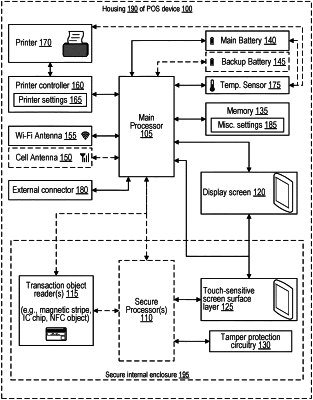| CPC G06F 1/28 (2013.01) [G06F 1/30 (2013.01); G06F 1/324 (2013.01); G06F 1/329 (2013.01); G06F 1/3212 (2013.01); G06F 1/3234 (2013.01); G06F 1/3243 (2013.01); G06F 1/3265 (2013.01); G06F 1/3284 (2013.01); G06F 1/3287 (2013.01); G06F 21/86 (2013.01); G06K 7/08 (2013.01); G06Q 20/204 (2013.01); G06Q 20/206 (2013.01); G06Q 20/209 (2013.01); G07F 19/209 (2013.01); G07G 1/12 (2013.01); H02J 13/00 (2013.01); H04N 1/00899 (2013.01); H04N 2201/0082 (2013.01)] | 20 Claims |

|
1. A method of device component management, the method comprising:
identifying an action to be performed using a first component of a point of sale (POS) terminal as part of a process to be performed using the POS terminal;
determining an estimated combined power draw rate from use of the first component to perform the action while a second component of the POS terminal and a third component of the POS terminal are also used;
determining that the estimated combined power draw rate exceeds a first threshold associated with risk of brownout to the POS terminal without exceeding a second threshold that is greater than the first threshold, wherein the second threshold is associated with a risk of blackout to the POS terminal;
determining, based on a power draw of the second component of the POS terminal and on a power draw of the third component of the POS terminal and on the process, that disabling the second component of the POS terminal is configured to reduce the risk more than disabling the third component of the POS terminal;
causing the POS terminal to temporarily disable the second component of the POS terminal while the POS terminal performs the action using the first component and until the action is complete without disabling the third component based on the determining that disabling the second component is configured to reduce the risk more than disabling the third component; and
causing the POS terminal to revert to use of the second component after the action is complete.
|